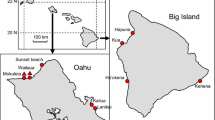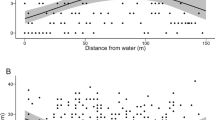Abstract
Jassa herdmani (Walker 1893), a tube-building amphipod typical of hard substrates, was found in large densities on shipwrecks from the Belgian part of the North Sea, in association with the hydrozoan Tubularia indivisa. In this area, shipwrecks only represent the source of hard substrates in an environment dominated by soft sediments. Nevertheless, the long-distance dispersal of Jassa species has never been investigated. Therefore, we tested the hypothesis of dispersal with currents, by investigating the behaviour of J. herdmani in the laboratory. Size distribution revealed that newly released juveniles (<1 mm) predominated throughout the year and the lower frequency of the size class 1–3 mm indicates a high mortality or a dispersal at this life stage. Individuals of J. herdmani may initiate actively the transport by tidal or surface currents by swimming to the surface of the water or by floating at the surface, as suggested by behaviours noted in the laboratory. The reaction of the amphipods to a current was investigated in the laboratory. We could not detect any sexual function associated with drifting and there was also no preponderance of a size class in the drifting individuals. When testing different substrates, we observed a significant influence of the substrate type on the frequency at which drifting occurred: J. herdmani showed a better adherence on T. indivisa compared to other substrates. Finally, the amphipod showed also a preference for its host compared to other substrates, which suggests a possible detection mechanism.





Similar content being viewed by others
References
Borowsky B (1983) Reproductive behavior of three tube-building peracarid crustaceans: the amphipods Jassa falcata and Ampithoe valida and the tanaid Tanais cavolinii. Mar Biol 77:257–263
Castilla JC, Guiňez R (2000) Disjoint geographical distribution of intertidal and nearshore benthic invertebrates in the Southern Hemisphere. Rev Chil Hist Nat 73:585–603
Conlan KE (1989) Delayed reproduction and adult dimorphism in males of the amphipod genus Jassa (Corophioidea: Ischyroceridae): an explanation for systematic confusion. J Crustacean Biol 9(4):601–625
Cummings VJ, Pridmore RD, Thrush SF, Hewitt JE (1995) Post-settlement movement by intertidal benthic macroinvertebrates: Do common New Zealand species drift in the water column? NZ J Mar Freshw Res 29:59–67
Franz DR, Mohamed Y (1989) Short-distance dispersal in a fouling community amphipod crustacean, Jassa marmorata Holmes. J Exp Mar Biol Ecol 133:1–13
Grant J (1980) A flume study of drift in marine infaunal amphipods (Haustoriidae). Mar Biol 56:79–84
Highsmith RC (1985) Floating and algal rafting as potential dispersal mechanisms in brooding invertebrates. Mar Ecol-Prog Ser 25(2):169–179
Hunte W, Myers RA (1984) Phototaxis and cannibalism in gammaridean amphipods. Mar Biol 81:75–79
Ingólfsson A (1995) Floating clumps of seaweed around Iceland: natural microcosms and a means of dispersal for shore fauna. Mar Biol 122:13–21
Ingólfsson A (1998) Dynamics of macrofaunal communities of floating seaweed clumps off western Iceland: a study of patches on the surface of the sea. J Exp Mar Biol Ecol 231(1):119–137
Johannesson K (1988) The paradox of Rockall: why is a brooding gastropod (Littorina saxatilis) more widespread than one having a planktonic larval dispersal stage (L. littorea)? Mar Biol 99:507–513
Kevrekidis T (2005) Life history, aspects of reproductive biology and production of Corophium orientale (Crustacea: Amphipoda) in Monolimni lagoon (Evros Delta, North Aegean Sea). Hydrobiologia 537:53–70
Locke A, Corey S (1989) Amphipods, isopods and surface currents: a case for passive dispersal in the Bay of Fundy, Canada. J Plankton Res 11(3):419–430
Lowry JK (1986) The callynophore, a eucaridan/peracaridan sensory organ prevalent among the Amphipoda (Crustacea). Zool Scr 15(4):333–349
Massin C, Norro A, Mallefet J (2002) Biodiversity of a shipwreck from the Belgian Continental Shelf: monitoring using scientific diving. Preliminary results. Bull Inst R Sc Nat Belg 72:67–72
Nair KKC, Anger K (1979) Experimental studies on the life cycle of Jassa falcata (Crustacea, Amphipoda). Helgol Wiss Meeresunters 32:444–452
Stock JH (1993) De marmerkreeftjes (Amphipoda: geslacht Jassa) van Nederland. Zeepaard 53(1):10–15
Thiel M (2000) Population and reproductive biology of two sibling amphipod species from ascidians and sponges. Mar Biol 137:661–674
Thiel M (2003a) Extended parental care in crustaceans–an update. Rev Chil Hist Nat 76:205–218
Thiel M (2003b) Rafting of benthic macrofauna: important factors determining the temporal succession of the assemblage on detached macroalgae. Hydrobiologia 503:49–57
d’Udekem d’Acoz C (1993) Présence et abondance de Jassa herdmani (Walker,1893) sur la côte belge (Crustacea, Amphipoda, Ischyroceridae). Strandvlo 13(4):134–138
Waage-Nielsen E, Hartvig C, Rinde E (2003) Short-term dispersal of kelp fauna to cleared (kelp harvested) areas. Hydrobiologia 503:77–91
Zintzen V, Massin C, Norro A, Mallefet J (2006) Epifaunal inventory of two shipwrecks from the Belgian Continental Shelf. Hydrobiologia 555:207–219
Acknowledgements
This study has been financially supported by a ‘plan Action II’ grant (contract number WI/36/C04) from the Belgian Science Policy and by the BEWREMABI project (Belgian Science Policy). J. Mallepet is a research associate of the FNRS. The present study has been performed in agreement with the current Belgian laws. The authors wish also to thank the crew of the RV Zeeleeuw and RV Belgica for their help during the sampling campaigns. It’s also our pleasure to thank all the people who helped collecting the samples: Dr. A. Norro, Dr. Y. Laitat, A. Simon, D. Delbare, E. Vanden Bergh, T. Schils, Mss C. Delforge and R. Gyssens and Mrs P.B. Demoulin, G. Rooms, D. Marsham, F. Cray, M. Van Espen, Y. Verkemping, M. Backx, J. Haelters, F. Hernandez, F. Darchambeau, G. Van Hoydonck, A. Vanhaelen, R. Knuts & P. Van de Steen.
Author information
Authors and Affiliations
Corresponding author
Additional information
Communicated by M. Wahl.
Rights and permissions
About this article
Cite this article
Havermans, C., De Broyer, C., Mallefet, J. et al. Dispersal mechanisms in amphipods: a case study of Jassa herdmani (Crustacea, Amphipoda) in the North Sea. Mar Biol 153, 83–89 (2007). https://doi.org/10.1007/s00227-007-0788-8
Received:
Accepted:
Published:
Issue Date:
DOI: https://doi.org/10.1007/s00227-007-0788-8




